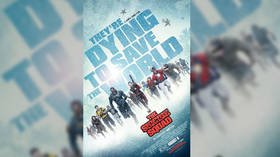‘The Suicide Squad’ is so politically subversive as to be shocking, especially for a Pentagon-approved corporate comic book movie

If viewers look hard enough, they’ll see the surprising anti-American imperialism, and even an eyebrow-raising suggestion that 9/11 was an ‘inside job’, hiding in plain sight in this decent-but-not-great movie.
This article contains spoilers for ‘The Suicide Squad’.
All director James Gunn had to do with his new movie ‘The Suicide Squad’ was make it not as awful as 2016’s ‘Suicide Squad’, directed by David Ayer.
I’m no Gunn fanboy, but he succeeded in this task by making a decent enough, very stylized comic book comedy that is best described as a foul-mouthed, blood-soaked, raucous romp akin to a second-rate ‘Deadpool’.
But Gunn’s greatest accomplishment with ‘The Suicide Squad’ was sneaking its remarkably subversive political message past his corporate overlords and censorious Department of Defense bureaucrats looking to trade an Osprey aircraft for content control.
How else to explain a mainstream comic book film that boasts symbolism which seems to hint at a ‘9/11 was an inside job’ conspiracy theory at its narrative heart, and anti-American imperialism at its sub-textural center?
The plot of ‘The Suicide Squad’ is that two ‘Suicide Squads’ of super-villains are sent on a mission by the US government to invade a small island off of South America, Corto Maltese, which was ruled by an American-friendly dictator now deposed by a hostile military coup.
The first group of Suicide Squad-ers hit the Corto Maltese beach like the Bay of Pigs invasion force, and meet a similarly gruesome fate.
When supervillain Savant tries to run away from the fray, US government official Amanda Waller detonates an explosive device implanted in his head, in a Stalinesque lesson to the others to never retreat.
None of this paints America in a very positive light.
This invasion is simply a distraction so that a second Suicide Squad, led by Bloodsport and made up of Peacemaker – a super patriot and psychopath – Ratcatcher, Polka-Dot Man, and King Shark, can arrive unnoticed on Corto Maltese.
As the Suicide Squad go on their odyssey, they mistakenly massacre a group of rebels intent on overthrowing the anti-American military junta due to Ms. Waller’s order to “kill anything they see.”
Again, not exactly the usual pro-US message the Pentagon prefers.
The Squad’s mission is to break into a heavily fortified tower named Jotunheim that houses a powerful, one-eyed Sauron-esque starfish alien named Starro, which can control entire populations of people by taking over their brains.
The US were complicit in capturing Starro from space, and now that an unfriendly government has taken over Corto Maltese, they want the Suicide Squad to blow up Jotunheim and kill Starro.
The Suicide Squad eventually get to Jotunheim and – hold onto your tinfoil hats – they place C4 explosives on each floor of the tower. But the plan goes awry and the explosions happen too early, thus the tower only partially collapses.
The visual similarities between the demolition of the Jotunheim and the WTC towers collapsing on 9/11 are pretty blatant, and one doesn’t have to be a ‘conspiracy kook’ to notice them.
For instance, Bloodsport escapes the tower’s initial collapse and finds himself atop what is left of the Jotunheim, but then the floor he’s standing on collapses to the floor below, which begins a cascading collapse where each floor pancakes onto the one below, with Bloodsport surfing the crumbling building to the bottom.
The symbolism when Bloodsport arrives at the bottom of the tower is striking, as he finds super-patriot Peacemaker poised to execute Ratcatcher at the behest of the American government so as to keep a computer file detailing the US’s involvement in Project Starfish from ever coming to light.
Donning an Izod shirt and short shorts, and brandishing a flag-waving, violent self-righteousness, Peacemaker is Reagan’s America incarnate, who’d do anything to maintain America’s ‘shining city on a hill’ image.
In the aftermath of the tower’s collapse, Starro escapes and sets out to control or kill the entire population of Corto Maltese – but the US government doesn’t care, as long as America’s connection to the alien is forever hidden.
Speaking of hidden, in a nod to Operation Paperclip, Jotunheim was built by Nazis who escaped Europe after World War II, which is not the only Nazi symbolism in the film. Javelin, part of the first Suicide Squad invasion force, is a former Olympian who uses his javelin as a weapon. He’s German, a model of Hitler’s dream of Aryan supermen, and Harley Quinn, who has a crush on him, uses his javelin to pierce the eye of Starro and ultimately destroy the alien, with the help of hordes of hungry rats (it’s a long story).
Also on rt.com Amazon’s ‘criminal’ decision to move Lord of the Rings filming from New Zealand to UK sparks epic debate over ‘real Middle-earth’As for Starro, the beast released by the tower’s destruction, it’s symbolic of the mindless militarism and neo-conservative groupthink belched up by America after the Twin Towers were destroyed. Similar to America’s militarism and neo-conservatism, which led to the disastrous and failed wars in Afghanistan, Iraq, Libya, Syria, and Yemen, Starro’s invincibility is punctured by a ragtag group with primitive weapons (javelin), assisted by the reviled that live in the shadows (rats).
With an authoritarian, deceptive, murderous American government slaughtering friendly rebels and shrugging at the massacre of innocent women and children, a super-patriotic sociopathic serial killer, Nazis, and implying 9/11 government nefariousness, this movie is definitely not the usual Pentagon-approved propaganda.
‘The Suicide Squad’ is, like most comic book movies, a corporate money grab and commercial for future corporate money grabs, but it’s also a movie with a gloriously subversive political message hiding in plain sight. That’s either a testament to James Gunn’s creative stealth, or to the winless-in-wars-over-the-last-80-years Pentagon beginning to slip in the propaganda department too. Regardless of how the message got there, the reality is that the film’s alternative politics are one of the things that make it at least a somewhat interesting and worthwhile watch.
Think your friends would be interested? Share this story!
The statements, views and opinions expressed in this column are solely those of the author and do not necessarily represent those of RT.














